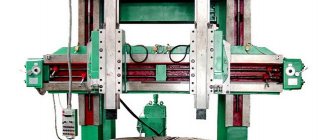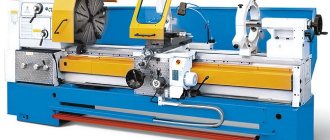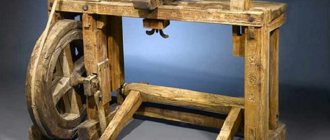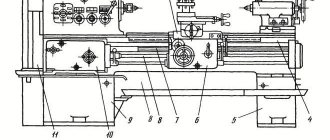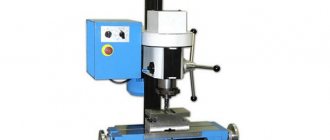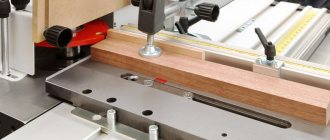Metal-cutting machines are machines for processing workpieces to a precisely specified size by removing a layer of allowance to form chips.
For work, an abrasive or blade cutting tool is mainly used. The machines also perform surface smoothing, roller rolling and other operations. Metalworking equipment allows processing of metallic and non-metallic materials. For example, nylon, textolite, various types of plastics and wood, but special machines are designed for processing hard materials (ceramics or glass).
Classification of units by groups
The main division of the array of metal-cutting machines occurs according to the technological method of processing, the method of moving mechanisms and the type of tool used.
There are 10 groups of machines:
- The first group is turning units. They make up about 30% of the machine park. Used for turning rotary parts. The cutting motion for the group is the rotation of the workpiece.
- The second is drilling and boring units. Their share is 20%, they are used for processing holes in various ways. Rotation of the tool and its feed with a stationary part are the main cutting movements. For boring machines, the table stroke with the part is added.
- The third is grinding, polishing, sharpening and finishing equipment. They make up 20% of the total number of such equipment. They work with an abrasive tool. Polishing and finishing units use abrasive paste and powder, sanding belts and bars.
- The fourth is devices for physical-chemical processing and combined ones. This group includes, for example, a unit for electrical discharge machining.
- The fifth group is gear-processing and thread-processing devices. They make up 6% of the entire fleet. Used for cutting different types of gears and threads. They perform roughing and finishing operations.
- Sixth – milling machines. Account for 15% of the total number of equipment. The working tools are multi-edge milling cutters of different designs.
- The seventh group is planing, broaching, and slotting machines. They account for 4% of machine tools. They have a linear working movement of the table. In slotting machines, the main movement is the reciprocating movement of the cutter. Broaching machines are used for processing holes and grooves using a multi-bladed tool - a broach.
- Eighth – cutting machines. Used for cutting workpieces such as circles, corners, rods.
- The ninth group is different machines. This group includes machines for balancing, straightening and other operations.
- The tenth is reserve. Multi-task machines such as CNC equipment and machining centers allow a number of machining methods to be implemented. In accordance with the type of operation performed, they are included in one of the machine groups.
How many types of metal cutting machines are there?
Table of commercially produced machines divided into nine groups of nine types
| Machine tools | Group | Types of machines |
| Turning | 1 | Specialized for shaped products |
| Drilling and boring | 2 | Horizontal drilling |
| Grinding, polishing, finishing | 3 | Lapping and polishing |
| Combined | 4 | Anode-mechanical |
Classification by type
Within each of the 10 groups, there is a division into 10 types in accordance with the following criteria:
- layout of basic units;
- processing method and tool used;
- level of automation and other technological features.
For example, the group of grinding and polishing machines includes cylindrical and surface grinding machines, longitudinal grinding and lapping machines. In the group of planing and slotting machines there are single-column longitudinal planers, transverse planers and slotters.
Within one type there is a division into 10 standard sizes.
The classification of metal-cutting machines according to a set of technological parameters is clearly presented in the table.
Classification of metal-cutting machines by accuracy class
The entire fleet of machining machines is divided into 10 groups. Each group has a division of 10 types, and each is further divided into 10 standard sizes.
The criterion for a group is the commonality of the technological method of processing or the similarity of purpose. For example, planing and broaching, gear processing and thread processing.
Each type combines a degree of versatility, the number of main working bodies, purpose, and design. Within a type, equipment differs in six technical parameters.
Reserve group 0 includes machines operating using the latest technological methods.
Metal cutting machines
Introduction
In the structure of the machine park of enterprises, all pieces of equipment are systematized and classified using various classifiers . Classification of machines is needed to organize the collected price and technical information, as well as to quickly find the necessary information about similar objects in the existing arrays of Information.
Multi-purpose classifiers include:
In addition, there are private, industry catalog and other classifiers used in various nomenclature catalogues, directory catalogs and price list catalogs for certain types of machinery and equipment.
The classifiers listed above are built according to a hierarchical classification method, which provides for the sequential division of a set of objects into classification groups subordinate to each other: classes, subclasses, groups, subgroups, etc. In this case, a consistent decimal coding system is used, when for each characteristic (grouping) a certain number of decimal places is allocated.
Organize by base size
Standards regulate the basic parameters of equipment characteristic of this type. For a group of turning and cylindrical grinding machines, this is the maximum size of the part for processing.
For milling machines, the main consideration is the size of the work table for installing workpieces and equipment. For cross-planing machines, the basic value is the stroke of the slider.
A set of machines for one type of processing, with similar kinematics and structure, but differing in main dimensions, is called a size range. For example, according to the standards, gear hobbing machines have 12 standard sizes with a maximum workpiece diameter for processing from 80 mm to 12.5 thousand mm.
The size range of lathes differs in the size of the workpiece: 250, 320, 400 and more. The introduction of size ranges unifies parts and facilitates the design and repair of machine tools.
Identification of the object of assessment
Classification of machines helps to accurately identify the object during evaluation. In this case, identification is understood as establishing identity between what is written in a document (passport, inventory card, description) and what actually exists. Identification of objects of assessment means, firstly, compiling or clarifying a list of assessed pieces of equipment based on their actual availability, i.e. carrying out a kind of inventory; secondly, checking and bringing into conformity with the real state of the basic initial information about the objects being assessed.
The identification work includes the following steps.
1. Clarification of the general characteristics of the equipment being assessed in accordance with the assessment assignment and the formation of an inventory list of the equipment being assessed.
2. Collection and verification of technical and other data for each object. Technical characteristics and parameters of objects can be presented both in expanded form and in abbreviated form - it all depends on the purpose of the assessment and the significance of the object being assessed.
For example, the most complete list of technical information about metalworking equipment is as follows:
- group, subgroup, type of equipment: general name and code according to the OKP and OKOF classifiers;
- name and model of the machine;
- Overall dimensions, mm;
- weight of the structure, t;
- main parameter and main technical characteristics;
- additional devices: for example, type and characteristics of CNC;
- electric motor power, kW;
- standard service life, years;
- repair complexity, units of repair complexity (u.r.s.) of mechanical, hydraulic, electrical parts;
- development organization;
- manufacturer
Additional classification
There is an additional division of machines:
- according to the degree of versatility, metal-cutting equipment can be universal and standard;
- for performing many types of operations, processing a wide range of products in size and shape: general purpose and narrow-profile;
- For a specific type of work on the manufacture of various parts, there is specialized equipment;
- for clearly specified work - intended for processing parts of the same configuration, but with different dimensions, for example, crankshafts, gearbox housings.
- special - performs certain operations with a clearly defined type of part in shape and slight fluctuations in size.
Universal machine equipment is used in small-scale production. Specialized and special machines with a high level of automation are in demand in large-scale and mass production, where large batches of parts are produced.
Special machine ROLLER 2800 CNC
Commodity nomenclature of foreign economic activity of the Customs Union (TN VED CU)
Commodity nomenclature of foreign economic activity of the Customs Union (TN FEA CU) - Classification of machine tools used by customs authorities and participants in foreign economic activity (FEA) for the purpose of carrying out customs operations. Adopted by the Customs Union Commission, the Federal Customs Service of Russia participates in the development and addition.
The Commodity Nomenclature for Foreign Economic Activity is an expanded Russian version of the Harmonized System (HS), developed by the World Customs Organization and adopted as the basis for commodity classification in the countries of the European Union and others. Each product is assigned a 10-digit code (for some products a 14-digit code is used), which is subsequently used when performing customs operations, such as declaring or collecting customs duties. This coding is used to ensure unambiguous identification of goods transported across the customs border of the Russian Federation, as well as to simplify the automated processing of customs declarations and other information provided to customs authorities when carrying out foreign economic activity by its participants. The classifier consists of 21 sections and 99 groups (77, 98 and 99 groups of the Commodity Nomenclature of Foreign Economic Activity are currently reserved and not used).
The 10-digit product code according to the Commodity Nomenclature of Foreign Economic Activity is:
2 first digits (for example, 72 - ferrous metals) - commodity group of the Commodity Classification of Foreign Economic Activity 4 first digits (for example, 7201 - pig iron and mirror, in ingots, blanks or other primary forms) - commodity item 6 first digits (for example, 720110 - cast iron unalloyed pig iron, containing 0.5% or less phosphorus) - commodity subposition 10 digits, full product code, which is indicated in the cargo customs declaration (for example, 7201101900 - unalloyed pig iron, containing more than 1 wt.% silicon) - commodity subposition.
The classifier “Commodity nomenclature for foreign economic activity” of the Commodity Nomenclature of Foreign Economic Activity and the Commodity Nomenclature of Foreign Economic Activity of the Customs Union is of interest primarily for appraisers who have to evaluate customs value. With the development of export-import operations, including those related to equipment, this classifier is becoming increasingly used.
An example of coding in the Tax Code:
XVI. (section) Machinery, equipment and mechanisms; electrical equipment; their parts; sound recording and sound reproducing equipment, equipment for recording and reproducing television images and sound, their parts and accessories.
84 - (group) Nuclear reactors, boilers, equipment and mechanical devices; their parts;
8458 — (position) Metal-cutting lathes (including multi-purpose lathes);
8458 11 — (subheading) Metal-cutting lathes (including multi-purpose lathes) with numerical program control;
8458 11 2000 — (subheading) Multi-purpose turning machines.
Division by accuracy classes
The entire variety of metalworking machines is divided by accuracy class:
- normal – H;
- increased – P;
- high – B;
- especially high – A;
- especially precise (master machines) – C.
Screw-cutting lathe 1V625MP of increased accuracy class
The main part of the machine equipment provides processing according to 6–9 accuracy grades. Machines belonging to classes A, B and C have increased requirements for operating conditions, this is due to their very high accuracy. Their installation requires separate rooms with constant temperature and humidity.
Metal-cutting machines cannot exist without markings. The letter designating the accuracy class, except for machines with normal accuracy H, is added to the marking. For example, 16K20P.
All-Russian Product Classifier (OKP) OK 005-93
Industry classifier of metal-cutting machines OK 005-93
The classification of machine tools in the All-Russian Product Classifier OKP OK005-93 is used to solve problems of product cataloging, including the development of catalogs and systematization of products in them according to the most important technical and economic characteristics. This purpose of the classifier is of interest for valuation activities, in particular for the construction of price list catalogs and databases containing price information.
OKP is the most detailed classifier of machine tools, including types of products. The structure of six-digit codes is as follows:
XX 0000 - product classes;
XX X000 - subclasses;
XX XX00 - groups;
XX ХХХ0 - subgroups;
XX XXXX - species.
Example of coding in OKP:
38 0000 – (class) Metalworking and woodworking equipment;
38 1000 – (subclass) metal-cutting machines;
38 1100 – (group) Lathe group machines
38 1140 – (subgroup) Lathe-backing machines, combined lathes and lobe lathes;
38 1148 – (type) Chuck lathes and screw-cutting lathes.
Using OKP codes helps you quickly find the information you need, which is very important when revaluing. As databases are created for individual types of machinery and equipment, the task of integrating them on the basis of a single classifier of assessment objects, for which it is advisable to use OKP, becomes increasingly important.
By degree of automation
Metal-cutting machines are often produced with an additional automation function. Depending on the degree of automation, machines are divided into the following types:
- manual control;
- semi-automatic, when the processing cycle is carried out automatically, and the operator changes the workpiece and turns on the machine;
- automatic machines, where many work cycles continuously occur automatically, without an operator, including tool replacement, loading and unloading of parts;
- CNC machines, they are produced with the function of quickly changing operating modes by adjusting the program.
CNC lathes
Modern metal-cutting machines are produced with additional equipment, this speeds up the process of processing the material. Craftsmen can increase the degree of automation in small-scale production by making greater use of machines with numerical (cyclic) program control (CNC). Their markings contain the letter F (C).
The number behind the letter indicates the type of control system:
- digital indication F1 – the system allows you to make a preliminary set of coordinates, the digital indication displays in numerical terms the current position and movement of the moving unit of the machine;
- rectangular or positional system F2;
- contour F3;
- universal F4 – combines contour and positional processing of a part.
Who works on the machines?
Milling operator (from German Fräser; machine operator) is a specialist in working on a milling machine.
Interesting materials:
What holiday is celebrated on June 12 in Russia? What percentage does Russian Post take for cash on delivery? What percentage of Russia's income comes from oil? What percentage of city residents live in Russia? What is the percentage of mineral resources in Russia? What is the divorce rate in Russia? Which region is the main fuel base of Russia? What Russian flag was there under the Tsar? Which Russian Kremlin is included in the UNESCO list? What is the highest quality Russian chocolate?
Designation principle
Models of metal-cutting machines have an original designation, in the form of a combination of letters and numbers.
The following marking order has been established:
- the initial number is the machine’s belonging to the group;
- the next component shows its type;
- the third and fourth indicate a characteristic parameter (workpiece size, table dimensions).
Decoding the machine markings
The letter after the first or second digit indicates modernization in terms of basic parameters. Any letter completing the marking other than A, C, B, H, M, P and F indicates a modification carried out with a change in the design of the units.
The letters A, C, P, B indicate the accuracy class. When a tool magazine appears at the machine, the letter M is added.
Modern types of metal-cutting machines are different. To designate CNC machines, F is used, but where there is a turret, it is present at the end of the marking P.
Such metal-cutting machines are very popular among craftsmen.
For example, the designation 2N135 indicates that this is a vertical drilling machine of the second group, type 1 with modernization N. The maximum diameter of the installed drill is 35 mm.
All-Russian Classifier of Fixed Assets (OKOF) OK 013-94
The classification of machine tools in the All-Russian Classifier of Fixed Assets is part of the Unified System of Classification and Coding of Technical, Economic and Social Information (ESKK) of the Russian Federation.
OKOF was developed for use on the territory of the Russian Federation to replace the All-Union Classifier of Fixed Assets.
When developing OKOF, the following were taken into account: International Standard Industrial Classification of all types of economic activities (ISIC), International Standard Industriel Classification of all Economic Activities (ISIC), international Classification of Main Products (CPC) Central Product Classification (CPC), United Nations standards according to the international system of national Accounts (SNA), Regulations on Accounting and Reporting in the Russian Federation, as well as the All-Russian Classifier of Types of Economic Activities, Products and Services (OKDP), for which ISIC and CPC are basic.
OKOF was developed in accordance with the State program for the transition of the Russian Federation to the accounting and statistics system accepted in international practice in accordance with the goal of developing a market economy.
The all-Russian classifier of fixed assets OKOF OK013-94, approved by Decree of the State Standard of the Russian Federation No. 359 of December 26, 1994, is intended primarily for the purposes of statistical accounting of fixed assets. It is useful for appraisers when an assessment is carried out during the revaluation of assets or during a frontal assessment of the entire property of an enterprise and orientation is needed both in the structure of fixed assets and in the structure of the types of objects themselves.
Groupings of objects in OKOF are formed mainly according to the characteristics of purpose associated with the types of activities carried out using these objects and the products and services produced as a result of these activities.
The general structure of nine-digit codes for the formation of groupings of objects in OKOF is presented in the following diagram:
X0 0000 000 - section of fixed assets (1 - tangible, 2 - intangible);
XX 0000 000 - subsection of fixed assets, taking into account their importance for the economy as a whole and established traditions (11 - buildings, 12 - structures, 13 - housing, 14 - machinery and equipment, 15 - vehicles, etc.);
Example of coding in OKOF:
10 0000 000 – (section) Material fixed assets;
14 0000 000 — (subsection) Machinery and equipment;
14 2922 000 – (class) Machine tools and equipment;
14 2922 100 – (subclass) Lathe group machines;
14 2922 105 – (type) Center lathes, screw-cutting lathes and lathes.
The division into classes, subclasses and types in OKOF coincides with the classification according to the All-Russian Classifier of Types of Economic Activities, Products and Services (OKDP).
Design
Basically all devices consist of:
- strong frame;
- work area;
- clamps or other devices for holding the workpiece;
- engine and belts transmitting rotation;
- tool for cutting (grinding).
An interesting question is what paint coatings are applied to metalworking equipment. The peculiarity of paintwork is that it can withstand increased friction, as well as high temperatures.
In the article we talked about machines for metal processing, and to complete the topic, watch a video:
